Mapping Digital Storytelling in Interactive Learning Environments
Abstract
:1. Introduction
- (1)
- What are the top published journals on DS in the education and educational research field?
- (2)
- What are the most frequently cited DS-related articles in the education and educational research field?
- (3)
- What are the publishing countries for DS studies in the education and educational research field?
- (4)
- Which publishing authors have conducted DS studies in the education and educational research field?
- (5)
- Which keywords frequently occur in research on DS in the education and educational research field?
- (6)
- What research methods and application domains have been applied in DS studies in the education and educational research field?
2. Materials and Methods
2.1. Search Criteria
2.2. Data Extraction and Analysis
3. Results
3.1. Data Distribution
3.2. Distribution by Journal
3.3. Top Highly Cited DS-Related Articles
3.4. Country’s Data Distribution
3.5. Author Efficiency
3.6. Research Method
3.7. Application Domain
3.8. Popular Keywords
4. Discussion
Strengths and Limitations
5. Conclusions
Author Contributions
Funding
Institutional Review Board Statement
Informed Consent Statement
Data Availability Statement
Conflicts of Interest
References
- Bouton, E.; Tal, S.B.; Asterhan, C.S. Students, social network technology and learning in higher education: Visions of collaborative knowledge construction vs. the reality of knowledge sharing. Internet High. Educ. 2021, 49, 100787. [Google Scholar] [CrossRef]
- Jarke, J.; Breiter, A. The datafication of education. Learn. Media Technol. 2019, 44, 1–6. [Google Scholar] [CrossRef]
- Abrorxonovna, K.D. The importance of applying online interactive methods in science and information technologies in the process of distance learning. Int. J. Discourse Innov. Integr. Educ. 2020, 1, 24–27. Available online: http://summusjournals.com/index.php/ijdiie/article/view/79 (accessed on 31 July 2022).
- Das, K. The role and impact of ICT in improving the quality of education: An overview. Int. J. Innov. Stud. Sociol. Humanit. 2019, 4, 97–103. Available online: https://ijissh.org/storage/Volume4/Issue6/IJISSH-040611.pdf (accessed on 31 July 2022).
- Lockee, B.B. Shifting digital, shifting context: (re)considering teacher professional development for online and blended learning in the COVID-19 era. ETR&D-Educ. Tech. Res. Dev. 2021, 69, 17–20. [Google Scholar] [CrossRef]
- Heck, E.; Tsai, M. Sharing therapeutic experiences of place: Co-creative digital storytelling as a way to explore connection to place. Emot. Space Soc. 2022, 43, 100879. [Google Scholar] [CrossRef]
- Cretu, D.M.; Morandau, F. Initial teacher education for inclusive education: A bibliometric analysis of educational research. Sustainability 2020, 12, 4923. [Google Scholar] [CrossRef]
- Lepper, M.R.; Chabay, R.W. Intrinsic motivation and instruction: Conflicting views on the role of motivational processes in computer-based education. Educ. Psychol. 1985, 20, 217–230. [Google Scholar] [CrossRef]
- Rasheed, R.A.; Kamsin, A.; Abdullah, N.A. Challenges in the online component of blended learning: A systematic review. Comput. Educ. 2020, 144, 103701. [Google Scholar] [CrossRef]
- Wood, R.; Shirazi, S. A systematic review of audience response systems for teaching and learning in higher education: The student experience. Comput. Educ. 2020, 103896. [Google Scholar] [CrossRef]
- Chen, X.; Zou, D.; Cheng, G.; Xie, H. Detecting latent topics and trends in educational technologies over four decades using structural topic modeling: A retrospective of all volumes of Computers & Education. Comput. Educ. 2020, 151, 103855. [Google Scholar] [CrossRef]
- Segura-Robles, A.; Parra-González, M.; Gallardo-Vigil, M. Bibliometric and collaborative network analysis on active methodologies in education. J. New Approaches Educ. Res. 2020, 9, 259–274. Available online: https://www.learntechlib.org/p/217625/ (accessed on 31 July 2022). [CrossRef]
- Huang, C.; Yang, C.; Wang, S.; Wu, W.; Su, J.; Liang, C. Evolution of topics in education research: A systematic review using bibliometric analysis. Educ. Rev. 2020, 72, 281–297. [Google Scholar] [CrossRef]
- Shen, C.W.; Ho, J.T. Technology-enhanced learning in higher education: A bibliometric analysis with latent semantic approach. Comput. Hum. Behav. 2020, 104, 106177. [Google Scholar] [CrossRef]
- Pinto, M.; Fernández-Pascual, R.; Caballero-Mariscal, D.; Sales, D.; Guerrero, D.; Uribe, A. Scientific production on mobile information literacy in higher education: A bibliometric analysis (2006–2017). Scientometrics 2019, 120, 57–85. [Google Scholar] [CrossRef]
- Laing, C.M.; Moules, N.J.; Estefan, A.; Lang, M. Stories that heal: Understanding the effects of creating digital stories with pediatric and adolescent/young adult oncology patients. J. Pediatr. Oncol. Nurs. 2017, 34, 272–282. [Google Scholar] [CrossRef]
- Çetin, E. Digital storytelling in teacher education and its effect on the digital literacy of pre-service teachers. Think. Skills Creat. 2021, 39, 100760. [Google Scholar] [CrossRef]
- Har, A.L.C.; Mohamad, J.Z.A.; Jamal, S.S. The benefits and drawbacks of using tablet-based digital storytelling in vocabulary learning among Malaysian young English as a second language learners. Asia Pac. J. Educ. Educ. 2019, 34, 17–47. [Google Scholar] [CrossRef]
- Yang, Y.T.C.; Chen, Y.C.; Hung, H.T. Digital storytelling as an interdisciplinary project to improve students’ English speaking and creative thinking. Comput. Assist. Lang. Learn. 2022, 35, 840–862. [Google Scholar] [CrossRef]
- Wu, J.; Chen, D.T.V. A systematic review of educational digital storytelling. Comput. Educ. 2020, 147, 103786. [Google Scholar] [CrossRef]
- Nair, V.; Yunus, M.M. A systematic review of digital storytelling in improving speaking skills. Sustainability 2021, 13, 9829. [Google Scholar] [CrossRef]
- Walters, L.; Green, M.; Goldsby, D.; Parker, D. Digital storytelling as a problem-solving strategy in mathematics teacher education: How making a math-eo engages and excites 21st century students. Int. J. Technol. Educ. Sci. 2018, 2, 1–16. Available online: https://www.learntechlib.org/p/207279/ (accessed on 31 July 2022).
- Dalim, S.F.; Azliza, N.Z.M.; Ibrahim, N.; Zulkipli, Z.A.; Yusof, M.M.M. Digital storytelling for 21st century learning: A study on pre-service teachers’ perception. Asian J. Univ. Educ. 2019, 15, 226–234. [Google Scholar] [CrossRef]
- Calik, I.; Seckin-Kapucu, M. Use of digital stories in Education in the 21st Century. Curr. Stud. Educ. Discip. 2021, 150, 116–149. Available online: https://www.isres.org/books/Current%20Studies%20in%20Educational%20Disciplines%202021_31_12-12-2021.pdf#page=156 (accessed on 31 July 2022).
- Badam, S.K.; Liu, Z.; Elmqvist, N. Elastic documents: Coupling text and tables through contextual visualizations for enhanced document reading. IEEE Trans. Vis. Comput. Graph. 2018, 25, 661–671. [Google Scholar] [CrossRef]
- Deng, S.; Xia, S. Mapping the interdisciplinarity in information behavior research: A quantitative study using diversity measure and co-occurrence analysis. Scientometrics 2020, 124, 489–513. [Google Scholar] [CrossRef]
- Han, G.; Luo, R.; Sa, K.; Zhuang, M.; Li, H. Bibliometric analysis of highly cited papers on resources and the environment in China. Sustainability 2022, 14, 604. [Google Scholar] [CrossRef]
- Shomoossi, N.; Rad, M.; Fiezabadi, M.; Vaziri, E.; Amiri, M. Understanding the research process and historical trends in English for medical purposes using scientometrics and co-occurrence analysis. Acta Fac. Med. Naiss. 2019, 36, 235–247. Available online: https://scindeks-clanci.ceon.rs/data/pdf/0351-6083/2019/0351-60831903235S.pdf (accessed on 31 July 2022). [CrossRef]
- Wang, S.; Chen, Y.; Lv, X.; Xu, J. Hot topics and frontier evolution of science education research: A bibliometric mapping from 2001 to 2020. Sci. Educ. 2022. [Google Scholar] [CrossRef]
- Ohler, J. The world of digital storytelling. Educ. Leadership. 2005, 63, 44–47. Available online: https://www.academia.edu/1039692/The_World_of_Digital_Storytelling (accessed on 31 July 2022).
- Phan, T.; McNeil, S.G.; Robin, B.R. Students’ patterns of engagement and course performance in a Massive Open Online Course. Comput. Educ. 2016, 95, 36–44. [Google Scholar] [CrossRef]
- Svendsen, S.H.B.; Ask, K.; Øygardslia, K.; Skotnes, C.E.; Ringrose, P.; Grut, G.; Røkenes, F. Migration narratives in educational digital storytelling: Which stories can be told ? Learn. Media Technol. 2021, 47, 201–215. [Google Scholar] [CrossRef]
- Robin, B.R. Digital storytelling: A powerful technology tool for the 21st century classroom. Theory Pract. 2008, 47, 220–228. [Google Scholar] [CrossRef]
- Sadik, A. Digital storytelling: A meaningful technology-integrated approach for engaged student learning. ETR&D-Educ. Tech. Res. Dev. 2008, 56, 487–506. [Google Scholar] [CrossRef]
- Yang, Y.T.C.; Wu, W.C.I. Digital storytelling for enhancing student academic achievement, critical thinking, and learning motivation: A year-long experimental study. Comput. Educ. 2012, 59, 339–352. [Google Scholar] [CrossRef]
- Hull, G.A.; Katz, M.L. Crafting an agentive self: Case studies of digital storytelling. Res. Teach. Engl. 2006, 41, 43–81. Available online: https://www.jstor.org/stable/40171717 (accessed on 31 July 2022).
- Hafner, C.A.; Miller, L. Fostering learner autonomy in English for science: A collaborative digital video project in a technological learning environment. Lang. Learn. Technol. 2011, 15, 68–86. Available online: http://llt.msu.edu/issues/october2011/hafnermiller.pdf (accessed on 31 July 2022).
- Hung, C.M.; Hwang, G.J.; Huang, I. A project-based digital storytelling approach for improving students’ learning motivation, problem-solving competence and learning achievement. Educ. Technol. Soc. 2012, 15, 368–379. Available online: https://www.jstor.org/stable/10.2307/jeductechsoci.15.4.368 (accessed on 31 July 2022).
- Xu, Y.; Park, H.; Baek, Y. A new approach toward digital storytelling: An activity focused on writing self-efficacy in a virtual learning environment. Educ. Technol. Soc. 2011, 14, 181–191. Available online: https://www.jstor.org/stable/10.2307/jeductechsoci.14.4.181 (accessed on 31 July 2022).
- Blue Bird Jernigan, V.; Salvatore, A.L.; Styne, D.M.; Winkleby, M. Addressing food insecurity in a Native American reservation using community-based participatory research. Health Educ. Res. 2012, 27, 645–655. [Google Scholar] [CrossRef]
- Hausknecht, S.; Freeman, S.; Martin, J.; Nash, C.; Skinner, K. Sharing Indigenous Knowledge through intergenerational digital storytelling: Design of a workshop engaging elders and youth. Educ. Gerontol. 2021, 47, 285–296. [Google Scholar] [CrossRef]
- Churchill, N. Development of students’ digital literacy skills through digital storytelling with mobile devices. Educ. Media Int. 2020, 57, 271–284. [Google Scholar] [CrossRef]
- Kantek, F.; Yesilbas, H. Conflict in nursing studies: A bibliometric analysis of the top 100 cited papers. J. Adv. Nurs. 2020, 76, 2531–2546. [Google Scholar] [CrossRef]
- Jimenez, C.; Clark, L.S.; Kennedy, H.; Nisle, S.; Engle, C.; Matyasic, S.; Anyon, Y. The art of youthful restraint: Negotiating youth-adult relations in digital media literacy. Learn. Media Technol. 2021, 46, 190–203. [Google Scholar] [CrossRef]
- Hava, K. Exploring the role of digital storytelling in student motivation and satisfaction in EFL education. Comput. Assist. Lang. Learn. 2021, 34, 958–978. [Google Scholar] [CrossRef]
- Mertala, P. Paradoxes of participation in the digitalization of education: A narrative account. Learn. Media Technol. 2020, 45, 179–192. [Google Scholar] [CrossRef]
- Kim, M.J.; Hall, C.M. What drives visitor economy crowdfunding? The effect of digital storytelling on unified theory of acceptance and use of technology. Tour. Manag. Perspect. 2020, 34, 100638. [Google Scholar] [CrossRef]
- Su, W.S.; Chang, C.Y. Virtual patient in interactive learning environments: A review of 1989–2020 publications in selected SSCI journals. Interact. Learn. Environ. 2021. [Google Scholar] [CrossRef]
- Ivanović, L.; Ho, Y.S. Highly cited articles in the education and educational research category in the social science citation Index: A bibliometric analysis. Educ. Rev. 2019, 71, 277–286. [Google Scholar] [CrossRef]
- Liu, K.P.; Tai, S.J.D.; Liu, C.C. Enhancing language learning through creation: The effect of digital storytelling on student learning motivation and performance in a school English course. ETR&D-Educ. Tech. Res. Dev. 2018, 66, 913–935. [Google Scholar] [CrossRef]
- Liu, C.C.; Yang, C.Y.; Chao, P.Y. A longitudinal analysis of student participation in a digital collaborative storytelling activity. ETR&D-Educ. Tech. Res. Dev. 2019, 67, 907–929. [Google Scholar] [CrossRef]
- Büyükkarci, A.; Müldür, M. Digital storytelling for primary school mathematics teaching: Product and process evaluation. Educ. Inf. Technol. 2022, 27, 5365–5396. [Google Scholar] [CrossRef]
- Molan, S.; Weber, D.; Kor, M. Shaping children’s knowledge and response to bushfire through use of an immersive virtual learning environment. J. Educ. Comput. Res. 2022, 60, 1399–1435. [Google Scholar] [CrossRef]
- Olitsky, S.; Becker, E.A.; Jayo, I.; Vinogradov, P.; Montcalmo, J. Constructing “authentic” science: Results from a university/high school collaboration integrating digital storytelling and social networking. Res. Sci. Educ. 2020, 50, 505–528. [Google Scholar] [CrossRef]
- Chen Hsieh, J.; Lee, J.S. Digital storytelling outcomes, emotions, grit, and perceptions among EFL middle school learners: Robot-assisted versus PowerPoint-assisted presentations. Comput. Assist. Lang. Learn. 2021, 55, 1969410. [Google Scholar] [CrossRef]
- Zhang, L.; Carter, R.A., Jr.; Qian, X.; Yang, S.; Rujimora, J.; Wen, S. Academia’s responses to crisis: A bibliometric analysis of literature on online learning in higher education during COVID-19. Br. J. Educ. Technol. 2022, 53, 620–646. [Google Scholar] [CrossRef] [PubMed]
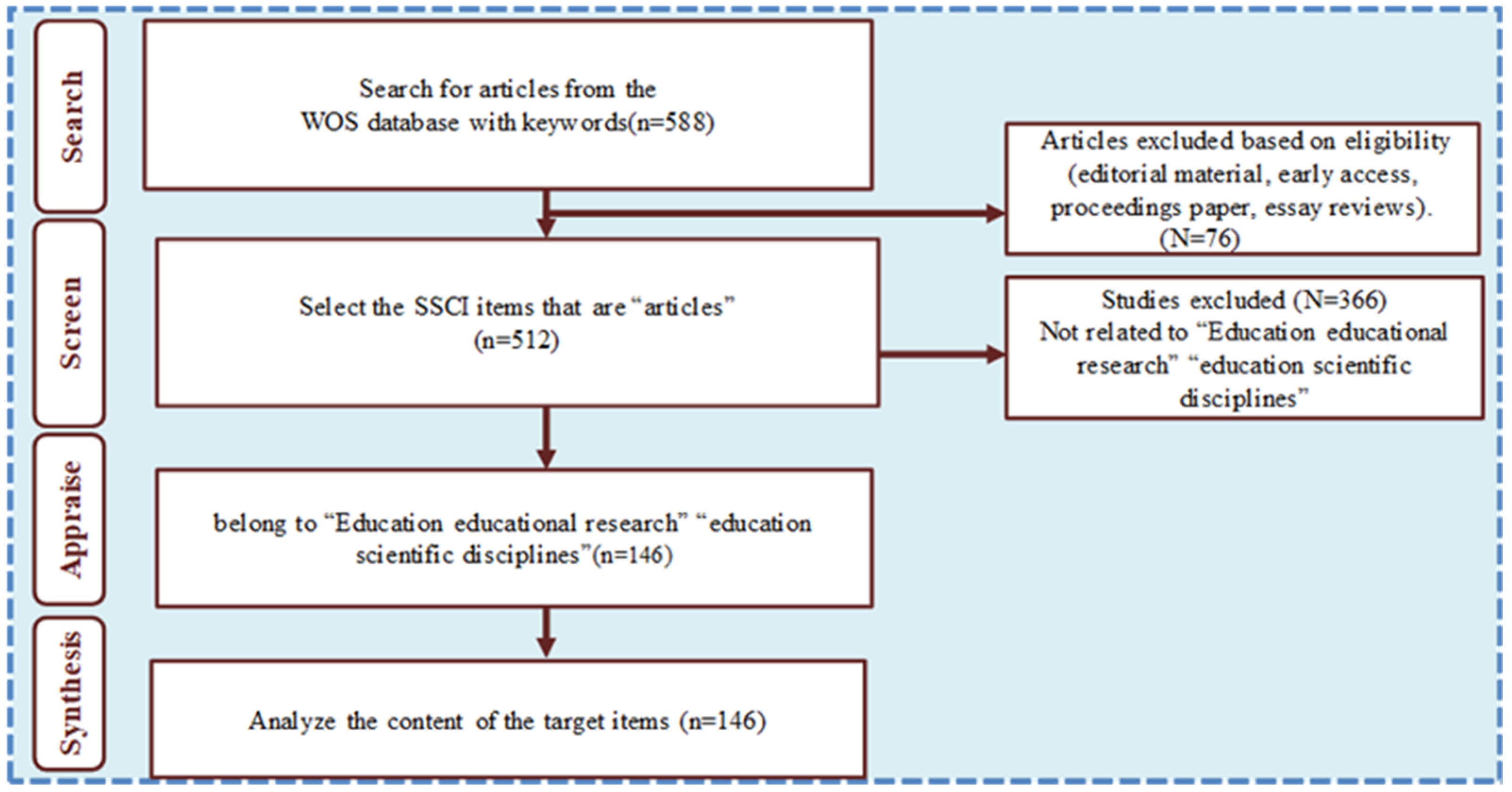
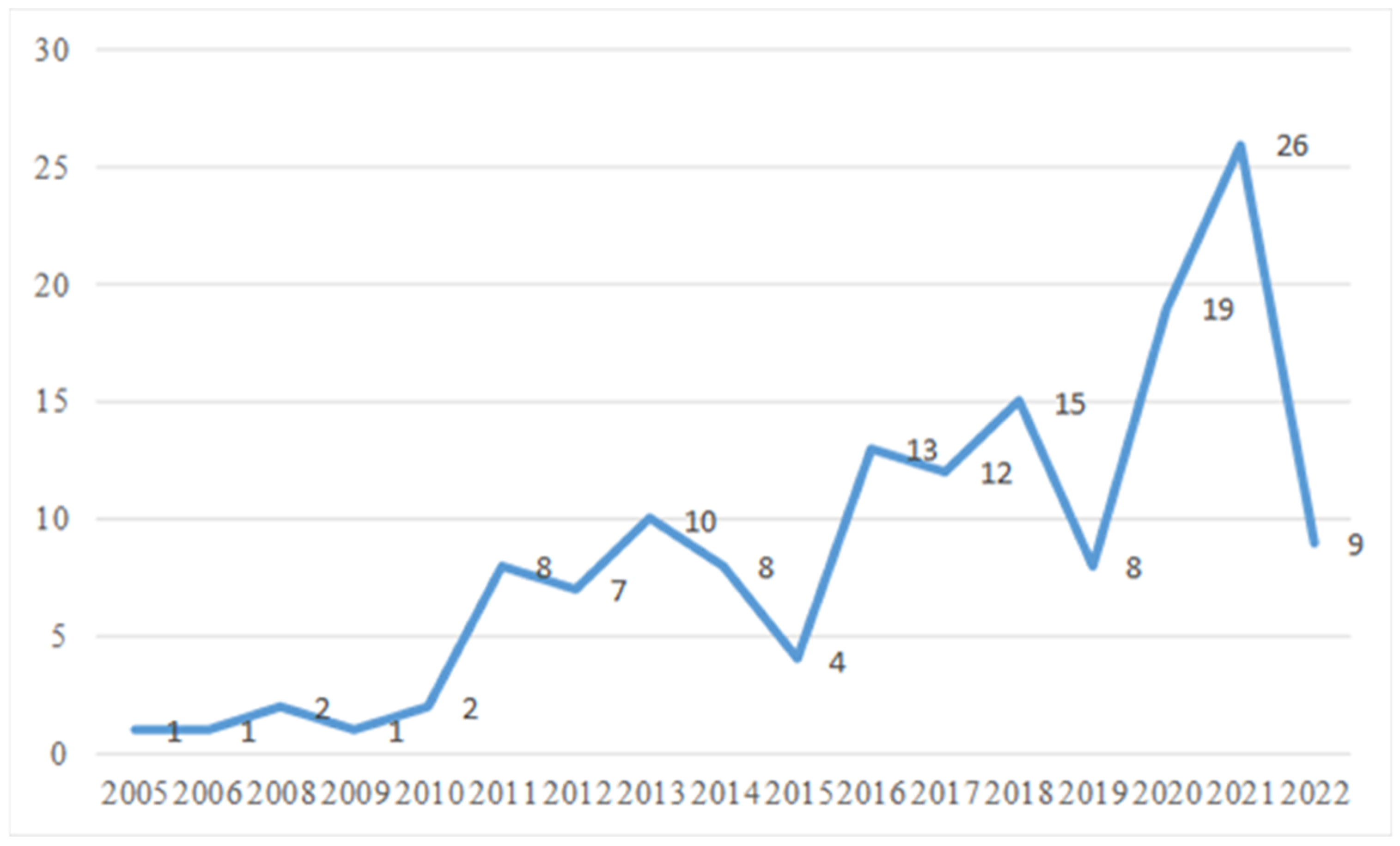
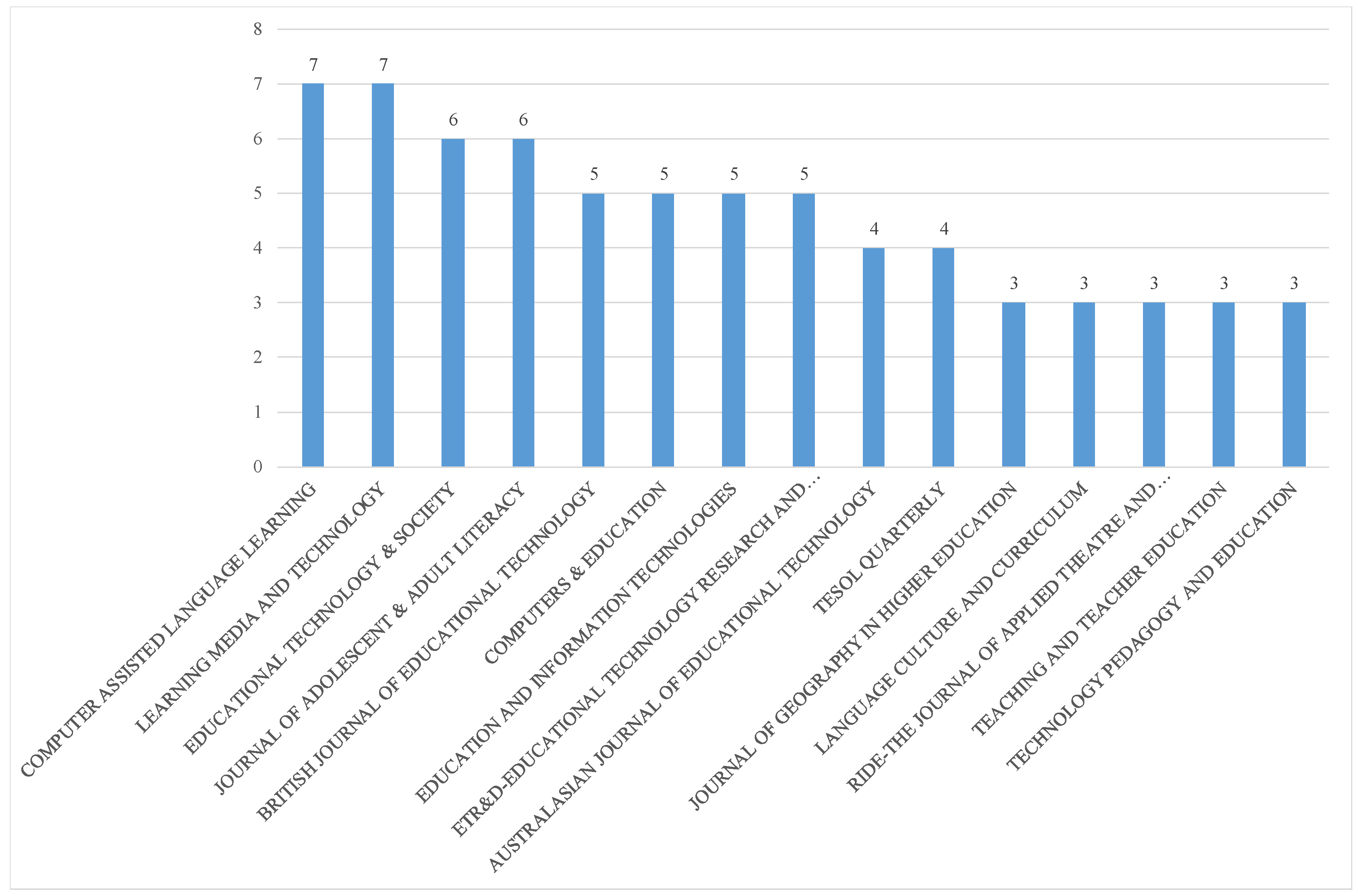
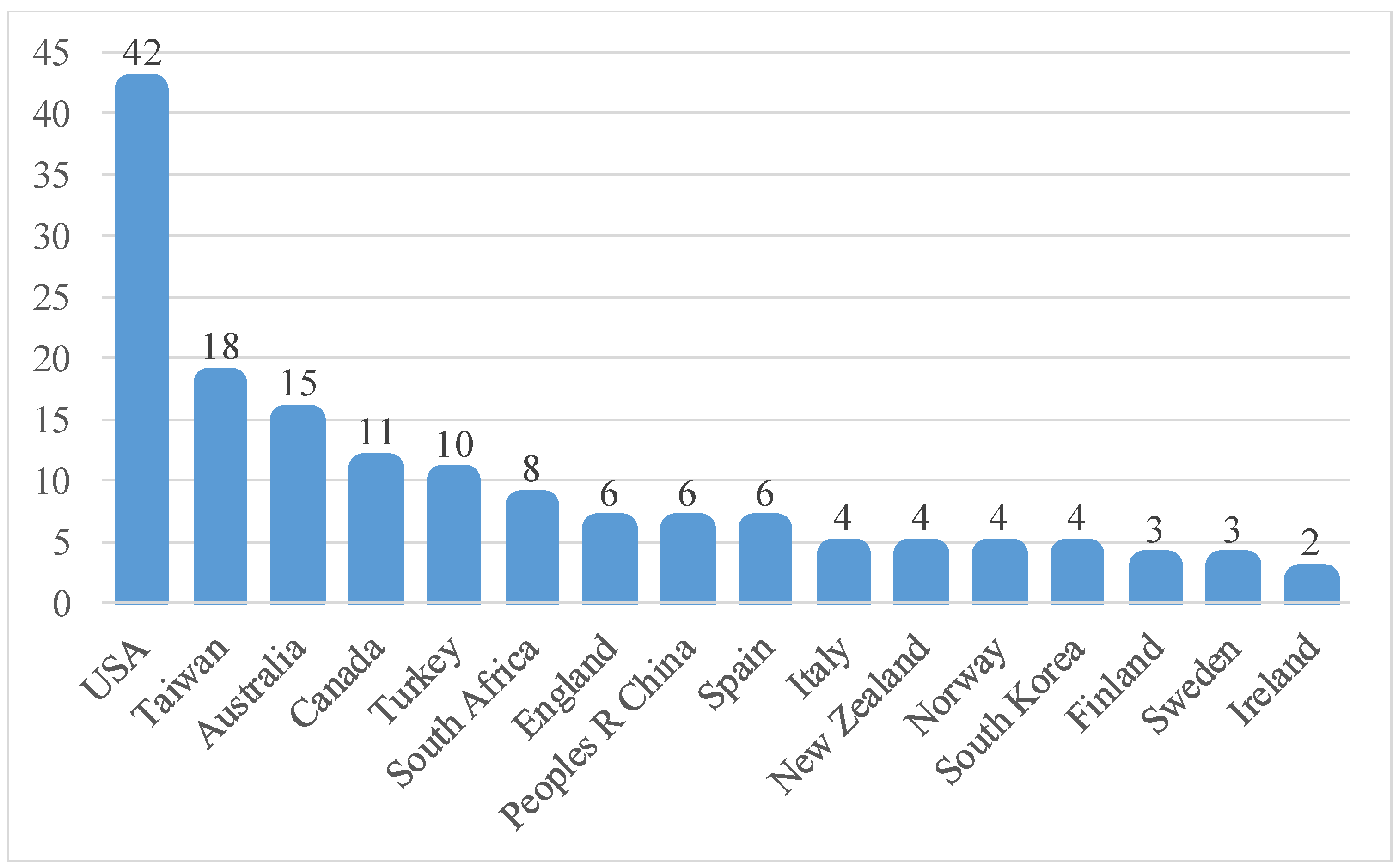
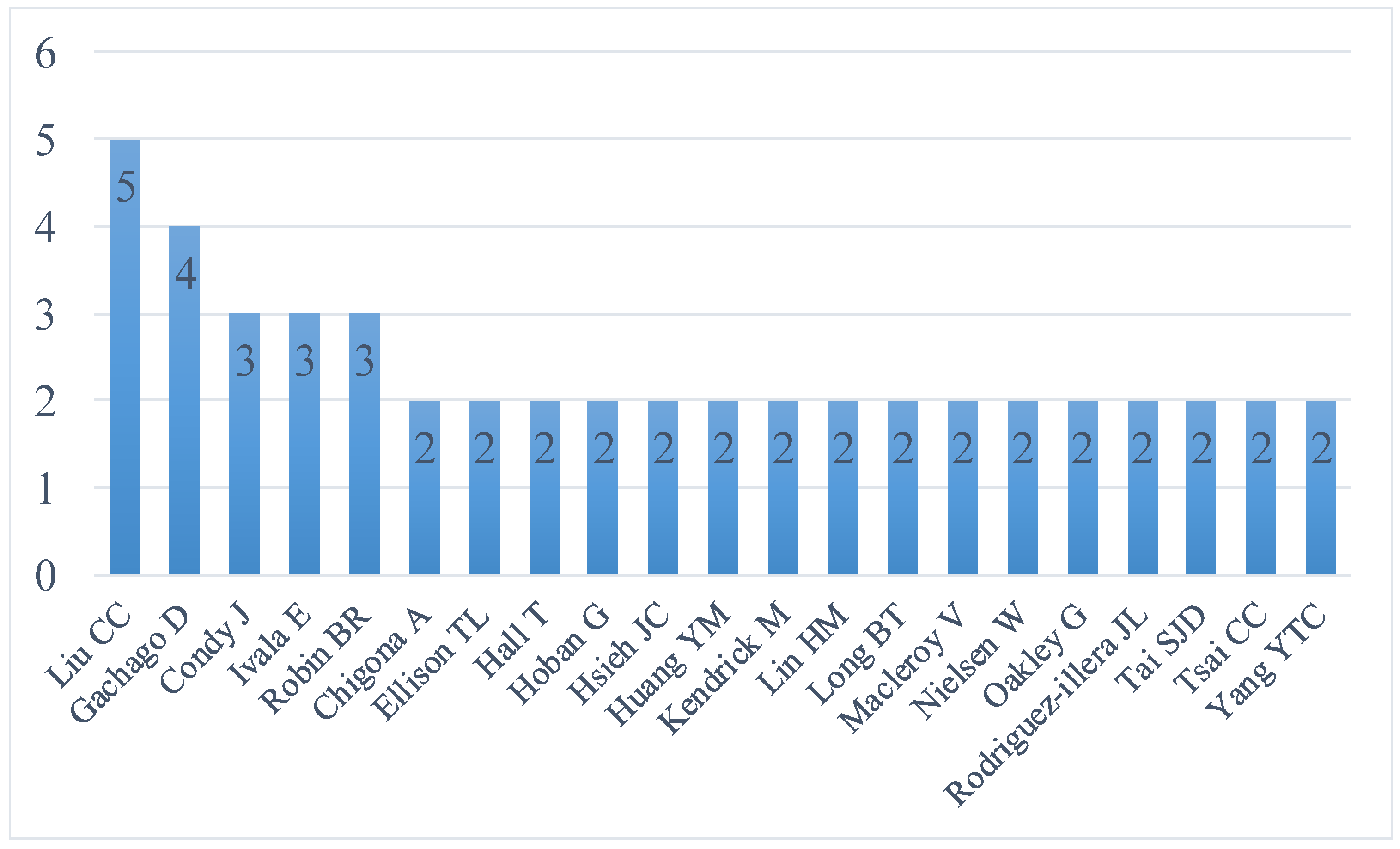
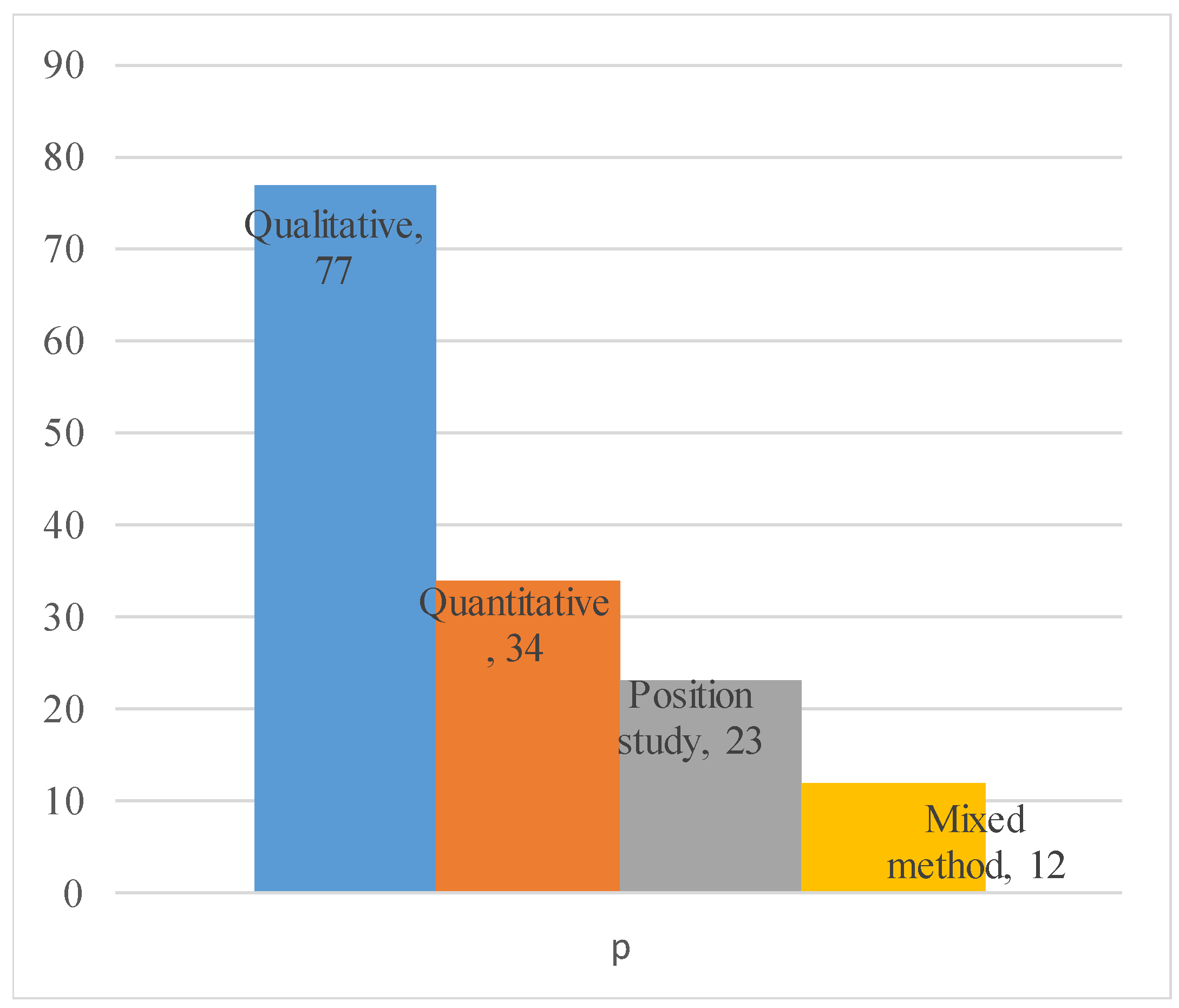
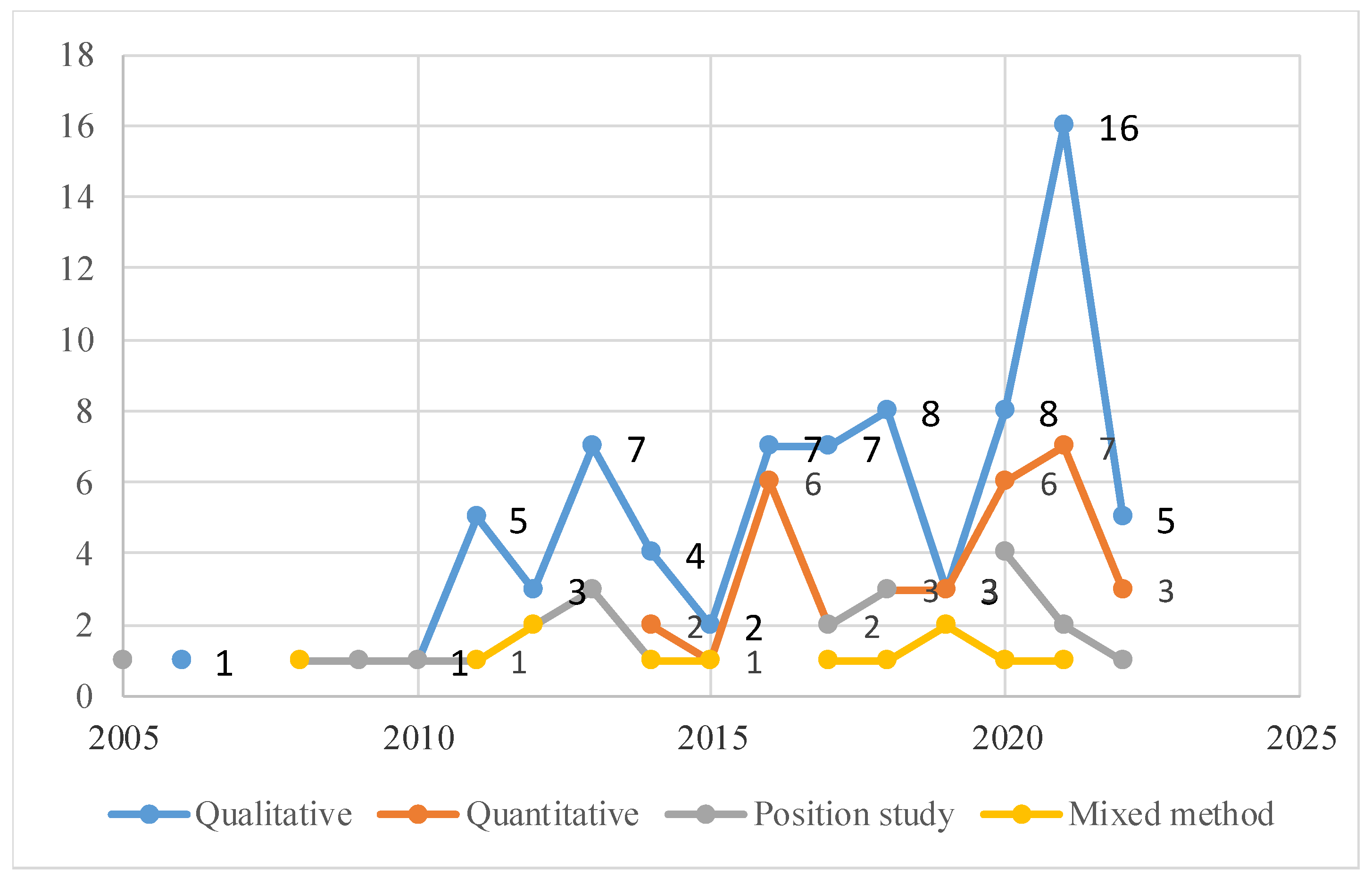
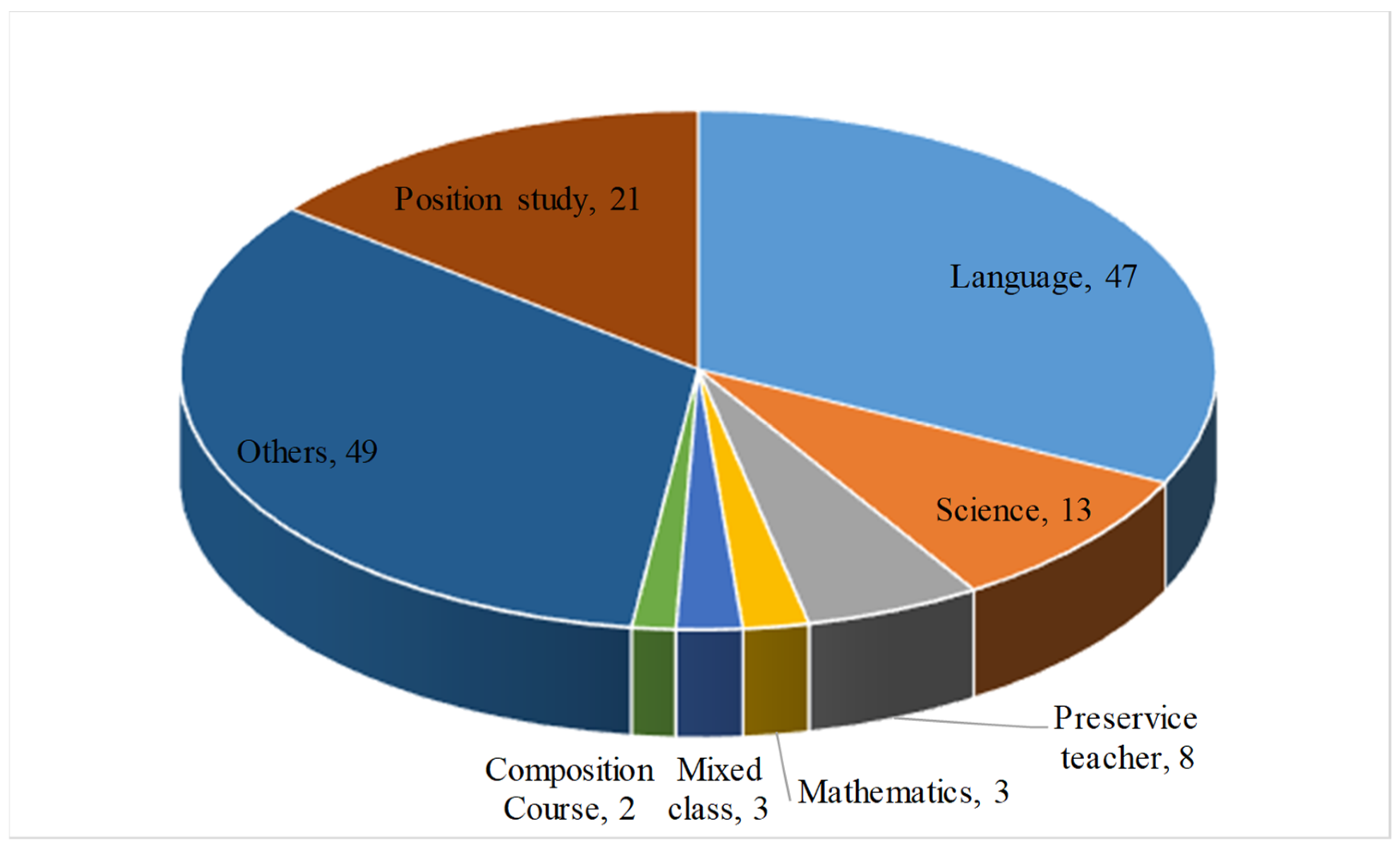
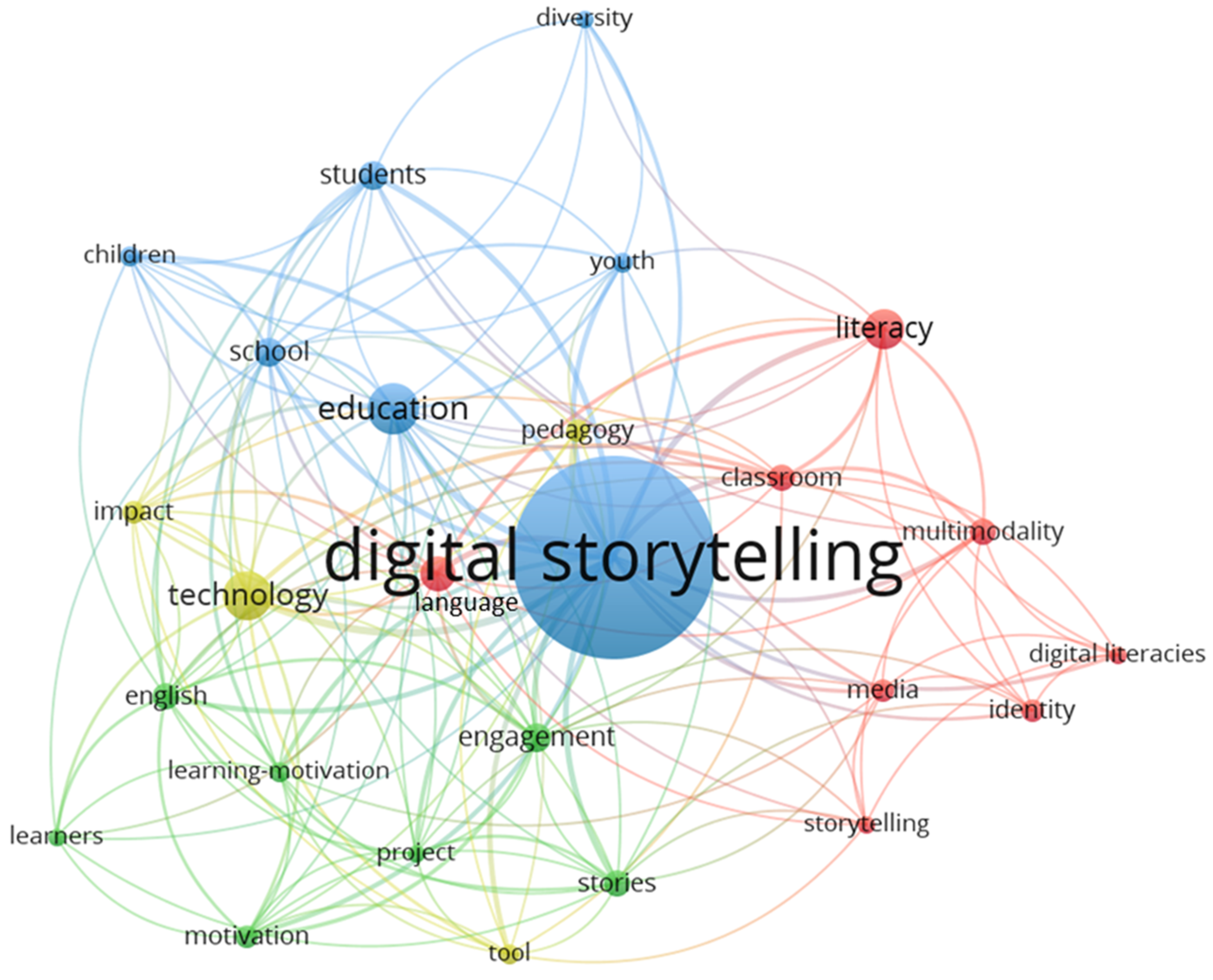
| Publication Source | Authors | Title | Number of Citations |
|---|---|---|---|
| Theory into Practice | Robin [33] | A powerful technology tool for the 21st-century classroom | 390 |
| ETR&D-Educational Technology Research and Development | Sadik [34] | A meaningful technology-integrated approach for engaged student learning | 279 |
| Computers & Education | Yang & Wu [35] | Digital storytelling for enhancing student academic achievement, critical thinking, and learning motivation | 223 |
| Research in the Teaching of English | Hull & Katz [36] | Crafting an agentive self: Case studies of digital storytelling | 191 |
| Language Learning & Technology | Hafner & Miller [37] | Fostering learner autonomy in English for science: a collaborative digital video project in a technological learning environment | 132 |
| Educational Technology & Society | Hung, Hwang, & Huang [38] | A project-based digital storytelling approach for improving students’ learning motivation, problem-solving competence, and learning achievement | 118 |
| Educational Leadership | Ohler [30] | The world of digital storytelling | 96 |
| Computers & Education | Phan, McNeil, & Robin [31] | Students’ patterns of engagement and course performance in a Massive Open Online Course | 81 |
| Educational Technology & Society | Xu, Y.,Park, & Baek [39] | A new approach toward digital storytelling: an activity focused on writing self-efficacy in a virtual learning environment | 77 |
| Health Education Research | Blue Bird Jernigan et al. [40] | Addressing food insecurity in a Native American reservation using community-based participatory research | 74 |
| Cluster 1 | Cluster 2 | Cluster 3 | Cluster 4 |
|---|---|---|---|
| digital storytelling | technology | literacy | engagement |
| education | tool | language | English |
| diversity | impact | classroom | learners |
| children | pedagogy | digital literacies | learning-motivation |
| school | identity | motivation | |
| students | media | project | |
| youth | multimodality | stories | |
| storytelling |
Publisher’s Note: MDPI stays neutral with regard to jurisdictional claims in published maps and institutional affiliations. |
© 2022 by the authors. Licensee MDPI, Basel, Switzerland. This article is an open access article distributed under the terms and conditions of the Creative Commons Attribution (CC BY) license (https://creativecommons.org/licenses/by/4.0/).
Share and Cite
Chang, C.-Y.; Chu, H.-C. Mapping Digital Storytelling in Interactive Learning Environments. Sustainability 2022, 14, 11499. https://doi.org/10.3390/su141811499
Chang C-Y, Chu H-C. Mapping Digital Storytelling in Interactive Learning Environments. Sustainability. 2022; 14(18):11499. https://doi.org/10.3390/su141811499
Chicago/Turabian StyleChang, Ching-Yi, and Hui-Chun Chu. 2022. "Mapping Digital Storytelling in Interactive Learning Environments" Sustainability 14, no. 18: 11499. https://doi.org/10.3390/su141811499






